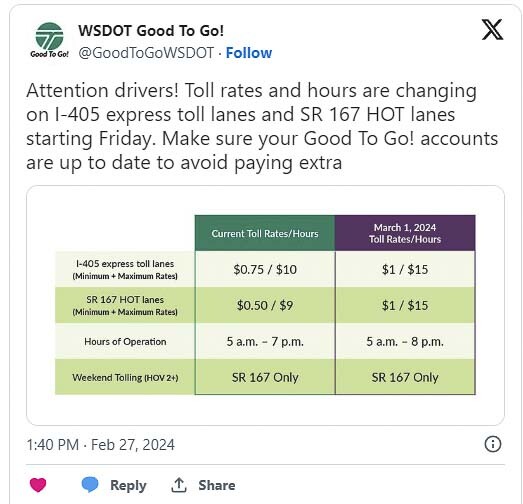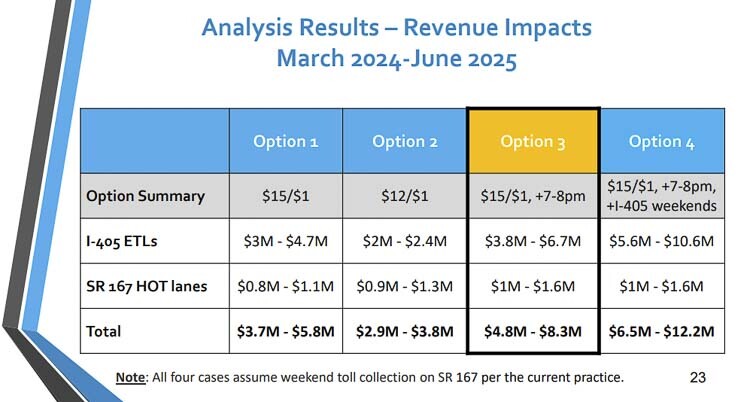Public opposition to tolling grows in Portland metro area
John Ley
for Clark County Today
The cost of driving to work could go up 50 percent or more Friday in the Puget Sound area. Both maximum and minimum toll rates increase on March 1 for drivers using the I-405 and SR-167 transportation corridor in the Puget Sound. There are three segments in the toll corridor. The hours tolls are collected will expand as well.
Following many months of discussion and mostly negative public input, the Washington State Transportation Commission (WSTC) approved “phase one” of toll rate increases at their January 29 meeting. The Commission will also continue discussions with WSDOT this year on Phase 2 of its rate setting process which could be implemented next year.
Maximum toll rates will increase from $9 on SR-167 and $10 on I-405, to $15 on both roads. Minimum rates will be $1. Toll lanes will still be free on weeknights between 8 p.m. and 5 a.m. and will continue to be free on I-405 on weekends. Officials said carpool requirements on both roads did not change.

This is of vital interest to Clark County and Portland area residents because two sets of tolls are planned to be implemented in this area beginning as early as April 2026. A recent Portland area community survey indicates 76 percent oppose ODOTs tolling plans. The WSTC received 14 emails in opposition to their tolling increase for every one in favor.
Last week, two members of the WSTC met with two members of the Oregon Transportation Commission (OTC) to begin setting rates for tolling the I-5 Interstate Bridge. Oregon has been holding public meetings on tolling since late 2017 following the passage of HB2017.
Oregon plans to put tolls on numerous bridges in the area, including the I-205 Abernethy Bridge, the Tualatin River bridge, and on the I-5 Wilsonville Boone Bridge, in addition to the Interstate Bridge. Separately, they want to charge a “per mile” toll, reported to be from 17 cents to 38 cents per mile, according to economist Joe Cortright.
Both tolls will be variable, with higher prices during periods when roads are congested and lower prices with moderate or no congestion. Cortright reported a round trip between Vancouver and Wilsonville could run $28 to over $30 per day.
Washington state has five separate tolling facilities, all of which required a bailout by the legislature during the three years of pandemic lockdowns. The SR-99 tunnel facility has been deemed “permanently underwater” by the Washington Department of Transportation (WSDOT).
WSTCs “dynamic pricing” plan means toll rates can change multiple times each hour. The more congested the toll lanes, the higher the price. A person driving all three segments at peak commute times could be paying $45 each way; $90 a day and potentially over $20,000 per year.
Federal law requires Express Toll Lanes (ETL) or High Occupancy Toll (HOT) facilities on interstate highways to average 45 miles per hour at least 90 percent of the time. When the state legislature approved tolls on both I-405 and SR-167, they also established this requirement. The I-405 corridor has yet to meet this federal and state requirement other than during pandemic lockdowns. The northbound direction currently meets this requirement
“During the peak where we have that express toll lane congestion, they need to allocate almost twice as much travel time to get between the two points,” said Karl Westby, WSDOT I-405/SR 167 program traffic operations lead. People continue to use privately owned vehicles as their primary mode of transportation.
“The I-405 ETLs had average vehicle speeds above 45 miles per hour 87 percent of the time during peak hours in the first half of 2023, while the SR 167 HOT lanes met the standard just 63 percent of the time,” reports the WSTC. Why won’t the Federal Highway Administration or state government remove tolling authority due to the corridor failing both state and federal law?

The Washington legislature directed WSDOT to identify approaches to help close funding gaps on numerous transportation projects. Bids for recently awarded projects on the I-405 / SR 167 ETLs corridor came in $275 million over cost estimates and planned funding, WSDOT reports. They blame inflation both nationally and locally, for the higher cost estimates.
The adopted toll rate increases are projected to raise between $4.8 and $8.3 million over the next 16 months. That equals about $6 million per year if higher revenues are attained. It would take about 45 years to pay off the $275 million funding shortfall.
Travel times on the corridor have been increasing. General purpose lane travel times increased by 3-9 minutes and Express toll lane travel times increased by 1-3 minutes, according to staff reports.
Nearly 5,000 comments were received by email during the public comment period on the Commission’s preferred option. A summary of public input:
• About 4,200 email comments opposed the proposal
• About 300 email comments supported the proposal
• About 500 email comments didn’t directly comment on the proposal (categorized as “other”)
Oregon opposition
There is growing concern about tolling in the Portland metro area. The cities of West Linn, Oregon City, Tualatin, and Wilsonville, along with the United Food & Commercial Workers Local 555, sponsored an independent survey of voters in the Portland metro region (Clackamas, Multnomah, and Washington counties) February 7-13 2024 to assess public attitudes about ODOT’s tolling proposals.
Key takeaways include the following.
Voters are opposed to the concept of tolling in the Portland Metro region. Overall, 76% of voters oppose tolling. Opposition to tolling is highest in Clackamas County at 91%, followed by Washington County at 76% opposed, and Multnomah County at 69% opposed.
Voters also specifically oppose ODOT’s Regional Mobility Pricing Project (RMPP) and the I-205 Toll Project. After being provided a description of the tolling projects, 71% oppose Regional Mobility Pricing, and 64% oppose the I-205 Toll Project. Only 8% of voters strongly support the RMPP and only 11% of voters strongly support tolling at the Abernethy Bridge.
Opposition to tolling in Multnomah and Washington County corresponds to voters’ proximity to potential tolls, highlighting that more voters oppose tolls proposed to be nearer to them. When presented with the I-205 Abernethy Bridge Toll Project in Clackamas County, 53% of Multnomah County voters and 64% of Washington County voters were in opposition. After being presented with the tolling concepts on Highways 217 and 26 being studied by ODOT, 70% of Multnomah County voters and 80% of Washington County voters opposed those tolls.

Also read:
- Expect delays on northbound I-5 near Ridgefield through May 9Northbound I-5 travelers near Ridgefield should expect delays through May 9 as crews work on improvements at the Exit 14 off-ramp to support future development.
- 6-cent gas tax hike central to new transportation deal in WA LegislatureA proposed 6-cent gas tax hike is central to a transportation funding deal under negotiation in the Washington Legislature, aimed at raising $3.2 billion over six years.
- Letter: C-TRAN Board improper meeting conductCamas resident Rick Vermeers criticizes the C-TRAN Board for misusing parliamentary procedure during a controversial vote on light rail.
- Opinion: TriMet’s ‘fiscal cliff’ a caution for Clark County taxpayersRep. John Ley warns that Portland’s financially troubled TriMet transit system could pose major risks to Clark County taxpayers as the I-5 Bridge replacement moves forward.
- Travel Advisory: Expect daytime delays on northbound I-5 near Woodland for guardrail repairs, April 18WSDOT will close the left lane of northbound I-5 near Woodland on Friday, April 18, to repair guardrail and improve driver safety.









